


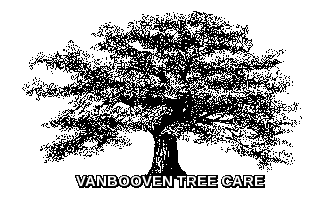
VanBooven Professional Tree Maintenance
Basic Pruning Concepts
Links Page
News
Employment
Opportunities
Tree Diseases and Preventative Treatments
By Brad Hatfield-ISA, Kansas Certified Arborist
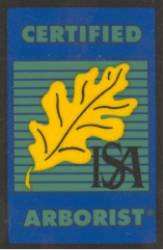
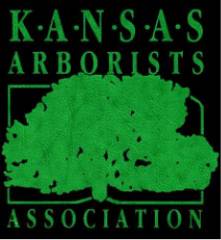
![]()
Dutch Elm
Disease-
All American and other native Elms are susceptible to this
disease. In the course of our
work,we see many Elms infected and dying every year. We have been
utilizing a macro-injection
system and the chemical Arbotect to treat Elms preventatively
with great success. Elm trees have to be injected
every two years with the fungicide Arbotect.Trees displaying
widespread signs of infection are generally not good
candidates for treatment.The fungicide only stays active and
working for a two year period, at which time the tree
will need to be injected again.
Symptoms
A general wilting or yellowing in the canopy, followed by a
distinct flagging of leaves.
Leaves brown and some hang on branches while others are quickly
shed.
In the early stage, it is possible to save trees by scribing
bark, pruning out infected limbs
and injecting with Arbotect. If the tree is infected by root
grafting to another infected
elm, it cannot be saved. Infected Elms showing symptoms
throughout the canopy or more
than 10-15 percent are a poor risk for treatment.
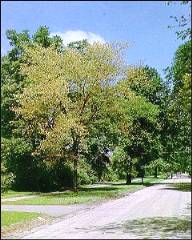
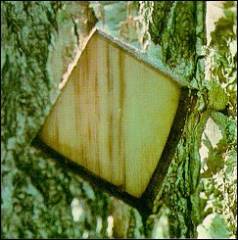
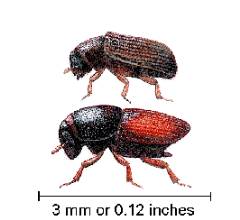
(Pictures courtesy of RainbowTree)
Above left-flagging and yellowing of leaves in American Elm.
Above middle-Bark removed to show streaking in
sapwood.Above right-Elm Beetle, responsible for spreading Dutch
Elm Disease.
Sanitation
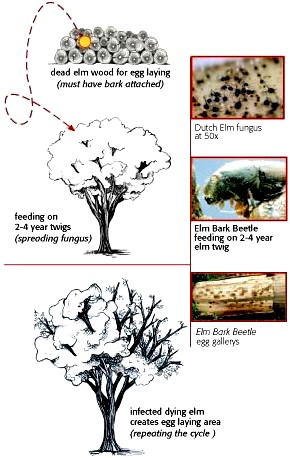
(Picture courtesy
of Rainbow Tree)
The picture above illustrates why infected Elms should be removed
promptly and not be allowed to over -winter, or
infected wood kept and stored as firewood.This provides a
breeding habitat and a way for overwintering eggs to
hatch and release a new generation of beetles to infect other
trees.Dutch Elm Disease can be spread from root
grafting to adjacent trees. There is also a distinct possibility
that the disease can be spread from
pruning tools or climbing spikes. Consider dormant pruning on
your Elms. If you have a specimen Elm or a
significant amount of Elms on your property, consider
preventative treatment.
![]()
Oak Wilt-
Oak Wilt has received a great deal of attention in the news
lately, but is a disease that Arborists see every year on a
limited scale.
Contrary to popular belief, the vast majority of Oak Wilt is
found in naturalized
stands of Red Oak, not in area neighborhoods. The symptoms of Oak
Wilt are very distinct!
Symptoms
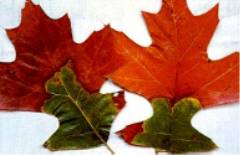
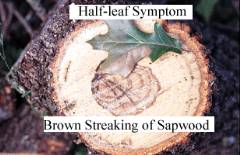
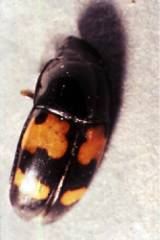
Above left-Distinct "half leaf" symptom of Oak Wilt.
Above Middle-Streaking in Sapwood and leaf symptom.
Above right-Nitidulid beetle-They feed on fungal spore mats and
can spread the disease via pruning cuts or
wounds.(Pictures courtesy of Kansas State University)
Leaves are quickly shed, caused by plugging in the vascular
portion of wood. The leaves themselves are
often a helpful diagnostic aid. Oak wilt infected trees have a
very distinct "half-leaf" symptom and also appear
waterlogged. The streaking in sapwood usually associated with
Wilt diseases is often absent in Oak Wilt infected
wood.When the temperatures go up, the fungus retreats to the
lower portion of the stem.The only way to get a
complete diagnosis is to send leaf samples and cuttings of 1-2
inch wood to the Extension Plant Pathology Lab
for confirmation.Oak Wilt can be difficult to culture in the lab,
so you can't always get a 100% confirmation.
We use a macro-injection system and Alamo fungicide to treat
at-risk trees. Infected Red Oaks generally do not
respond well because of vascular plugging, a defensive internal
reaction to the presence of the attacking fungus.
Trees close to Oak Wilt infection sites should be treated
preventatively and you must trench between
infected trees or in areas with multiple infected/at-risk trees
to sever root graft. The most common way this disease
spreads ist hrough root grafting.
Consider dormant pruning on your Oak trees, particularly Red
Oaks.
Do not allow anyone wearing climbing spikes into your Oak trees.
Although Oak Wilt can be
spread by climbing spikes and pruning equipment, the most typical
spread is through root grafting,
between trees with a shared root space. Nitidulid beetles can
also spread the disease.
These beetles feed on fungal spore mats in infected trees.This
type of beetle would be attracted
to wounds and pruning cuts. This disease can spread quickly in
areas dominated by Red Oak.
Map showing areas of Oak Wilt infection(USDA Forest Service)
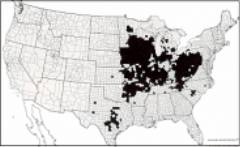
![]()
Hypoxylon
Canker of Oaks
As an Arborist in the Kansas City area, I have become accustomed
to seeing many varieties of diseases and pests
afflicting area trees. Our company is often called upon to
diagnose and treat these problems. There is a fungal
canker known as Hypoxylon (Hypoxylon atropunctatum) affecting Oak
trees in the metro area, particularly Red
Oaks. Although it does not get a great deal of attention, this
aggressive canker causes the death of large diameter
limbs and can ultimately kill Oak trees.
This is not a new , exotic pathogen. Hypoxolyn Canker is visible
in Oak trees all around us. Many large size limbs
or stems that die out can be attributed to this canker. Hypoxylon
Canker is naturally occurring in forested areas.
It is becoming much more common in urban sites when people cause
damage to roots and root zones.
Trees infected with or dying of Hypoxylon are often misdiagnosed
as having Oak Wilt.
You have to be able to recognize the symptoms, which are very
distinct! According to Dr. Ned Tisserat, former
Kansas State Director of Plant Pathology, Hypoxylon Canker is
latent, or dormant in many Oaks. The tree is able
to function and live with the fungal infection until it becomes
severely stressed or damaged. At that time, when
energy levels are low, the fungal canker becomes active and
spreads.
Symptoms
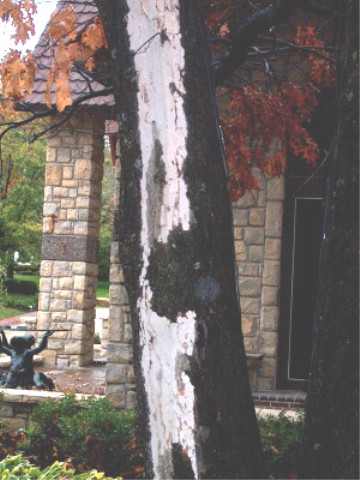
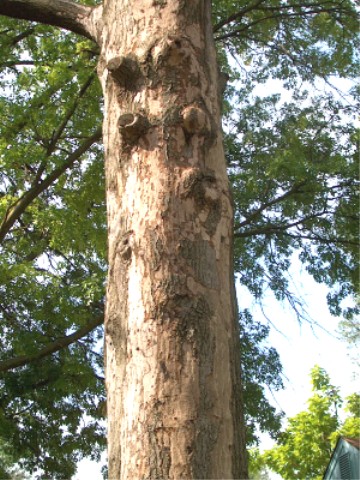
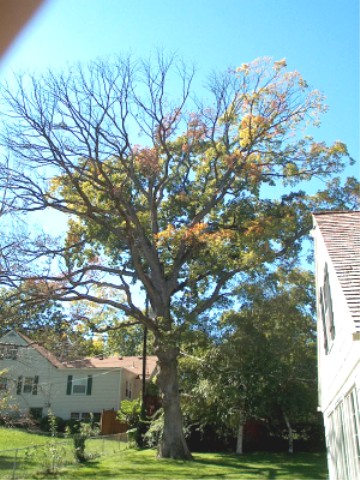
Photos of Hypoxylon Canker on Oaks-Far left and middle, two Red
Oaks that died from Hypoxylon. Far right, a
very large White Oak dying from Hypoxylon infection.
The most obvious early symptom of Hypoxylon is the sloughing off
of bark. The bark falls or peels off to expose a
dusty- looking brown canker. This early stage of the canker is an
active stroma,which bears brown masses called
conidia. The one-celled conidia are scattered by the wind and can
cause infection to other trees. The active canker
soon hardens, changing color to silver or grey and as the sexual
stage progresses, begins to produce black spores.
These spores can be spread by rain or insect activity to other
branches of the same tree or to other individual
trees. Cankers can easily spread 3 feet in one season of growth.
Large Red Oak trees can die within one or two
years of displaying symptoms of infection. White Oaks seem to be
more resistant to the fungus, but I witnessed a
very large, mature White Oak dying of Hypoxylon infection in
Missouri last year and have seen other White Oaks affected in the
past.
Control
There is no legitimate or effective control for Hypoxylon Canker.
The fungus remains active on dead wood, so
infected or suspect wood should never be kept or stored. Infected
limbs or stems can be pruned out, but use good
judgement based on percentage of unaffected canopy. Even after
pruning, there is a likelihood of canker spread
and dieback. Trees that have not lost more than 10-15 percent of
canopy would benefit from supplemental watering in dry
conditions and aeration/fertilization. Avoid root injury and
monitor trees closely that have
been impacted by construction, soilcompaction or drought stress.
It is possible that this
fungus could enter fresh pruning cuts and or injury by climbing
spikes and could be spread from
spikes or pruning tools. Dormant pruning is the safest way to go
on Oak trees.
It is important to note that the majority of trees I have seen
infected with Hypoxylon have been impacted by
construction activities. Root injury, in my opinion, is the
number one way for this fungus to overcome the natural
boundaries and defenses that Oaks possess.
Avoid digging in or disturbing the root zones of any trees,
particularly Oaks. If workers do any
trenching or digging under the dripline of your trees-Take
Pictures! Document the size and location of any root
disturbance, write down the date, the name of the company and how
long the job took. Trees do not always show
symptoms of root injury right away. Cutting or damaging roots can
weaken any tree, leaving it vulnerable to the
first opportunistic pathogen that happens to be in the
neighborhood. Utilities and contractors will deny
any damage to your tree or roots, will tell you they have a
"special" way of doing the work that doesn't hurt trees
and will hire some type of "tree guy" that will try to
find something else wrong with your tree! If you have any
doubts about the condition of your trees, contact an Arborist!
![]()
Pine Wilt
Although Pine Wilt is not a disease, it has become so widespread,
we feel it should be included.
*We are
starting to see more Austrian Pines infected in Kansas City.
**Kansas State University Plant Pathology confirmed our
suspicions, Pine Wilt on Austrian Pine is on the rise, with
a higher rate of positive identification in the KSU Lab.
If you drive or walk around the Kansas City area and look closely
at the surrounding landscape, you will see
wilting Pines. It seems that most neighborhoods are affected . I
have been responding to an extremely high
number of diagnostic calls that are Pine related. Unfortunately, we
are now seeing more Austrian Pines affected by Pine Wilt.
Pine Wilt has been active in the Midwest for the last twenty
years or so and until recently, roughly 90% of
Pines killed in the Midwest have been Scotch Pines. Pine Wilt is
not new to our area, but it appears to be more
common and widespread, with Austrian Pines now being affected.
Difficulties with Pine trees is a common experience in the
Midwest. It is important to look at the big picture,
especially when dealing with Scotch Pines. We have taken Scotch
and Austrian Pine trees, suited to temperatures
and environmental conditions in Europe, and have planted them
extensively here in the Midwest. They have done
fairly well and in some cases done well for great periods of
time. But now we have some events occurring together
that are killing these trees at an alarming rate.
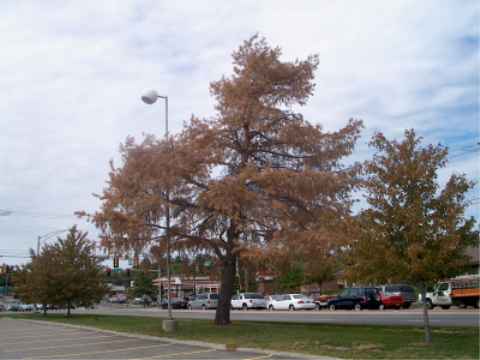
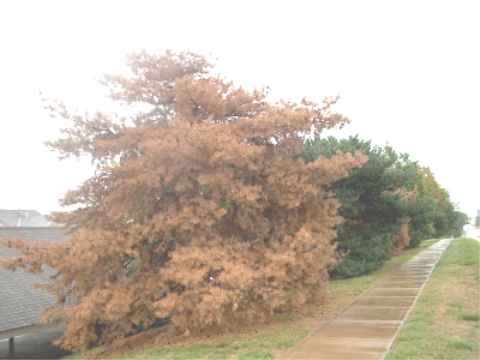
Pictured above-Pine Wilt in Overland Park
The explosive summer heat and the droughts we have been
experiencing play a role in the demise of Scotch and Austrian
Pines.
These environmental stresses that Pines are enduring create an
opportunityfor any specific pathogen. In the case
of Pine Wilt, it starts with the Pine Sawyer Beetle feeding on
Pine twigs. The feeding itself causes little damage.
However, the Pine Sawyer carries a microscopic, worm-like
creature called a nematode in it’s trachea. When
feeding, the Pine Sawyers’ wounds create an entry for the
nematode. The nematode enters the healthy Pine.
Resistant Pines cause the nematode to die out. In susceptible
Pines, the nematode begins to feed on living cells in
the resin canals. As the nematodes feed and multiply, the resin
canals become clogged, which eventually stops the
flow of water in the tree.When this happens, the wilt symptoms
begin to develop and the tree begins to die.
In addition, the
dying Pines attract bark beetles, which carry a blue-stain fungi.
As the bark beetles bore into the dying pines, the nematodes
begin to multiply by feeding on the blue-stain fungi,
supplied by the bark beetles. Pines infected with the Pine Wilt
nematode typically die within a period of a few weeks,but some
can linger for a month or two. Most of the Scotch Pines affected
are over 10 years of age.
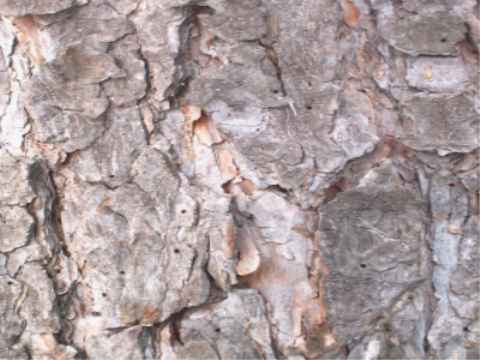
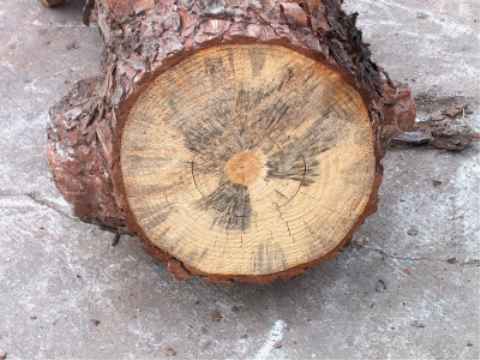
Pictures above left-Beetle activity indicated by close up of
borer holes. Right-Blue stain fungi on affected Scotch
Pine.
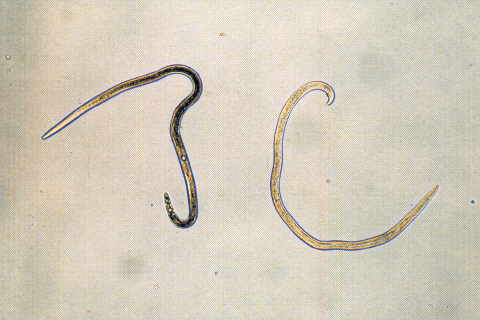
Above-Picture of Pine Wilt Nematode
Treatments
*At this time, there are some chemicals being
marketed for treating Scotch & Austrian Pines preventatively.
Trees must be injected with chemicals prior
to infection.
This is a relatively new process, can be expensive and the best
we have heard is
70% to 80% control. We will not endorse/use it until costs come
down and we see more
data or a higher percentage control rate.
The most
important management tool for control is sanitation. Dead Pines
will become
breeding grounds for beetles/nematodes. Remove dead or dying
trees as soon as possible and do not store any of
this wood as firewood. Remove tree completely and grind out
stumps. There is some debate over root graft spread
of nematodes, so you may have to consider trenching in areas
heavily planted with Scotch Pine. Even a single
infected Pine tree left standing can become an infection center
that will devastate other Pines nearby.
Consider planting other less problem prone trees. Eastern Red
Cedar, Juniper,
Hemlock and Baldcypress do well in our area and have a much
better
life expectancy. We are must now accept that Scotch, Austrian and
White Pinecan get Pine Wilt and each have
their own problematic baggage.
Spruce trees are an acceptable replacement, but do not always
thrive in our environment.
If you are looking for smaller sized trees for screening, try
something native like a Redbud, Serviceberry or
plant one of the many varieties of Crabapple.
![]()
Pine
Needle Fungus
VanBooven Arborists are generally dealing with three different
types of Pine Needle fungus, Sphaeropsis/Diplodia,
Dothistroma and Brown Spot. Of the three, Sphaeropsis is the most
serious, with Scotch and Austrian Pines being severely damaged or
killed over time.
Sphaeropsis
Tip Blight
This fungus is a problem for Austrian and Scotch Pine,
particularly on older or mature trees.
Tip Blight stunts and kills new growth on these Pines. If not
treated, Tip Blight will cause the gradual death of large limbs
and over time the entire tree may decline and die.
The fungus overwinters on cones, branches and dead tips, with
most infection occuring on the new growth (tips) in
the Spring. The crucial factors in controlling this problem is
timing your fungicide sprays to protect the susceptible
new growth and accurate, thorough spray coverage.Sphaeropsis is
very common in the Kansas City metro area.
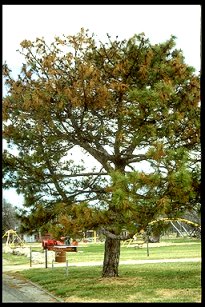

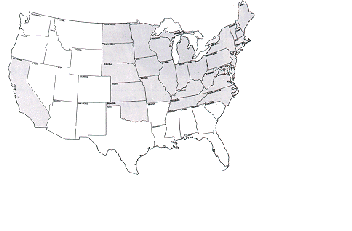
(Photographs courtesy of US Forest Sevice)
Left-Austrian Pine infected with Tip Blight, Middle- shows
pycnidia on cones, Right-Map of states affected by
Tip Blight are marked in grey.
Dothistroma
Needle Blight
Dothistroma affects mainly Austrian Pine in the Kansas City area.
Symptoms are very distinct, with a heavy shedding / browning of
inner needles and heavy spotting and or banding
of individual needles. The early shedding of needles needed by
the Pines can lead to loss of health and repeated
loss of foliage by continued infection(over several years) can
lead to severe decline or death of Pines.
Dothistroma infection of Austrian Pine is very common in the
Kansas City area, but can be controlled by proper
applications of fingicide.
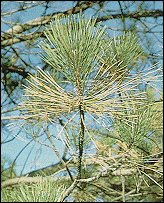
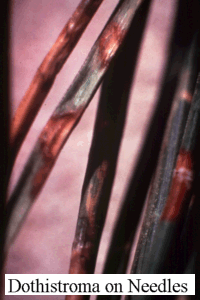
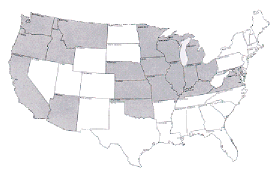
(Left and right photo courtesy of US Forest Service, middle
Kansas State University)
Left-Infected Pine shedding needles, Middle shows
spotting/banding of diseased needles, Map of states affected,
shaded grey.
Brown Spot
Fungus
Scotch Pines in the Kansas City area are fairly susceptible to
Brown Spot, but Brown Spot infection is not as
widespread as Tip Blight or Dothistroma. Symptoms are similar to
Dothistroma but a close inspection of needles
will reveal black fruiting bodies of the fungus on needles, as
opposed to the spotting/banding of Dothistroma.
Infected Pines should be treated with a fungicide spray.
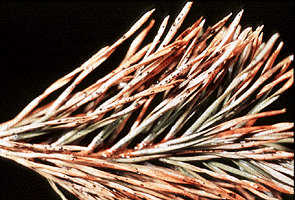
(photo courtesy of Kansas State University)
Picture above shows very distinct symptoms of Brown Spot.
![]()
If you have a question about your trees, we have an answer. To
speak with a Certified Arborist,
please contact us at 913-403-TREE.
VanBooven Tree Care Home Page
VanBooven Professional Tree Maintenance
Links Page
News